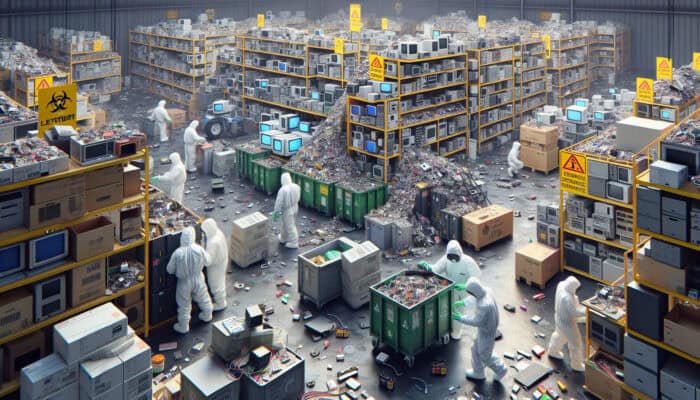Comprehensive Guide to Electronics Clearance: Safeguarding Our Environment
Defining Electronics Clearance: A Responsible Approach

Cost of Clearing Electronics in the UK: Electronics clearance encompasses the meticulous process of responsibly disposing of or recycling electronic devices to prevent environmental degradation. As the accumulation of electronic waste escalates, this practice has become increasingly vital for consumers and businesses alike in the UK. Proper disposal procedures are crucial to prevent toxic materials, such as lead and mercury, from contaminating soil and water systems, thereby safeguarding public health. Furthermore, effective clearance facilitates the recovery of precious materials, which can then be repurposed in the manufacturing of new electronic products, thus promoting a sustainable cycle of reuse.
In the UK, the surge in consumer electronics has resulted in a troubling backlog of electronic waste. As devices become outdated or cease functioning, many individuals find themselves uncertain about the most effective disposal methods. Therefore, grasping the concept of electronics clearance transcends mere regulatory compliance; it embodies a commitment to making ethical choices that foster environmental sustainability.
The Critical Importance of Responsible Electronics Clearance
The importance of proper electronics clearance cannot be emphasised enough. With the omnipresence of electronic devices, the quantity of e-waste is increasing at a staggering rate. Improper disposal methods can lead to catastrophic environmental repercussions, including contamination of soil and water sources. Therefore, engaging in responsible clearance practices is crucial to mitigating the environmental impact of electronic waste.
Moreover, adhering to these best practices aligns with broader societal objectives, such as achieving the UK’s environmental targets and advancing sustainability initiatives. Individuals and organisations that prioritise responsible electronics clearance can significantly contribute to a healthier planet while fostering a culture of recycling and reuse. It is also important to note that failure to comply with clearance regulations can lead to substantial fines and penalties, underscoring the necessity for everyone to be informed and involved in responsible clearance efforts.
Understanding Key Regulations Affecting Electronics Clearance in the UK
The UK has established a framework of regulations governing the disposal and recycling of electronics, with the Waste Electrical and Electronic Equipment (WEEE) Directive being the most prominent. This directive requires manufacturers to assume responsibility for the end-of-life management of their products. It obligates producers to furnish consumers with essential information regarding the responsible disposal of their electronics.
In conjunction with the WEEE Directive, local authorities are required to follow specific guidelines concerning the collection and treatment of e-waste, ensuring that local services are equipped to manage such items safely. Non-compliance with these regulations can result in legal consequences for both businesses and individuals. Familiarising oneself with these regulations not only facilitates responsible disposal but also enhances public awareness regarding environmental stewardship, a growing concern among citizens in the UK.
Understanding the Financial Aspects of Electronics Clearance

Exploring Disposal Fees for Electronic Devices
The costs associated with disposing of electronics can vary significantly depending on the type and size of the device. For example, disposing of small appliances such as toasters or kettles may incur minimal fees, typically ranging from £5 to £15. However, larger devices such as televisions and refrigerators often attract higher fees, which can range from £20 to £50. This variability in costs can deter many individuals from clearing out their outdated electronics, leading to increased waste.
It’s essential to note that some local councils in the UK incorporate disposal fees into council tax or designate specific collection days for e-waste, making the process more accessible for residents. For businesses, the financial implications of electronics disposal can accumulate rapidly, particularly when managing larger quantities of devices. Understanding these costs is vital for effective budgeting, as unexpected fees may arise, especially when hazardous materials are involved.
Assessing Recycling Costs for Electronics
The process of recycling electronic devices often incurs its own set of costs, although certain services offer free recycling options for specific items. Many retailers across the UK have adopted take-back schemes, enabling consumers to return old electronics at no extra cost when purchasing a new device. This initiative not only helps consumers declutter their homes but also promotes responsible recycling practices.
However, not all items qualify for free recycling, and consumers may face charges for recycling particular devices. These costs can vary from approximately £10 for smaller electronics to as much as £30 for larger items such as laptops or printers. Being mindful of these expenses can help households and businesses evaluate their options, allowing for informed decisions that consider both budgetary constraints and environmental impact.
Additional Fees in Electronics Clearance

During the clearance of electronics, additional charges may arise, particularly for the special handling of hazardous materials or for disposing of large quantities of items. For instance, the disposal of devices containing lithium batteries or CRT monitors typically incurs extra fees due to the specialised processes required for their safe handling. Costs for such items can range from £10 to £100, depending on the service provider and the complexity of the disposal process.
For businesses, these additional charges can become especially significant, particularly when clearing out old stock or office equipment. Adequate planning and awareness of potential extra costs can substantially influence overall clearance expenses. Businesses should consult with professional clearance services to obtain a detailed estimate of all possible fees before initiating the clearance process.
The Importance of Data Destruction Fees in Electronics Clearance
A crucial aspect of electronics clearance is ensuring that sensitive data is thoroughly erased from devices before they are disposed of. Fees for data destruction can vary widely, typically ranging from £10 to £50 per device, contingent on the method used. For example, a simple factory reset may incur lower costs. At the same time, more secure procedures, such as physically destroying hard drives, tend to be on the higher end of the pricing spectrum.
For businesses, investing in secure data destruction is not merely a financial consideration but a critical step in safeguarding sensitive information. Numerous professional clearance services offer certified data encryption, ensuring that vital data breaches are avoided. Understanding these fees is particularly crucial for businesses handling confidential information, as the long-term expenses associated with a data breach can significantly exceed the costs linked to proper data destruction.
Effective Methods for Clearing Electronics
Utilising Local Council Services for Electronics Disposal
A multitude of local councils throughout the UK have established electronics clearance services aimed at assisting residents in the responsible disposal of their electronic waste. Often included in council tax, these services may encompass scheduled collection days for e-waste or designated recycling centres where residents can conveniently drop off their outdated devices. Such services not only simplify the disposal process but also significantly reduce the environmental burden of electronic waste.
Local councils typically provide detailed guidelines regarding the types of electronics accepted and whether any associated fees apply. Councils may also collaborate with private recycling companies to ensure the efficient processing of electronic waste. Engaging with local services fosters a sense of community responsibility. It contributes to the UK’s overarching recycling objectives, making it a convenient and environmentally friendly choice for individuals seeking to dispose of their electronics responsibly.
Engaging Private Recycling Companies for Comprehensive Clearance
While local council services provide invaluable support, many individuals and businesses may opt to engage private recycling companies for their electronics clearance needs. These companies often deliver comprehensive services, including collection, recycling, and data destruction. Although typically more costly than council services, private recycling firms may offer enhanced convenience and specialised expertise, particularly for businesses managing substantial volumes of electronic waste.
Private companies often promote their commitment to environmentally responsible practices, ensuring that all materials are recycled sustainably. This transparency is appealing to businesses striving to improve their sustainability credentials. Additionally, many of these companies can tailor their services to accommodate specific requirements, offering bulk clearance options or managed services that streamline the disposal process while ensuring adherence to relevant regulations.
Exploring DIY Clearance Options for Cost Savings
For those seeking to economise on electronics clearance, DIY options can present a viable alternative. Numerous designated recycling centres across the UK permit individuals to drop off their old electronics for free or at minimal cost. Researching local options can uncover various opportunities for responsible disposal without incurring substantial expenses.
When selecting DIY options, it is crucial to verify that the recycling centres are certified and comply with environmental regulations. Furthermore, individuals should consider the types of electronics they intend to dispose of, as certain items may necessitate special handling. Although DIY clearance may require more effort, it can be an empowering way to contribute to environmental sustainability while saving money.
Assessing the Environmental Impact of Electronics Clearance
Strategies for Reducing Electronic Waste Through Responsible Practices
The escalating volume of electronic waste poses a pressing environmental challenge, particularly in the UK’s urban areas. Proper electronics clearance plays a vital role in mitigating this waste by ensuring that devices are either recycled or disposed of safely. And responsibly. By participating in responsible disposal practices, both individuals and businesses can collectively reduce the volume of e-waste that ultimately ends up in landfills, where it can take years to decompose and leach harmful substances into the environment.
Recycling electronics not only curtails waste but also conserves precious natural resources. Valuable materials such as gold, silver, and rare earth metals can be extracted from old devices, which helps to decrease the demand for new raw materials. This process is crucial for fostering a circular economy, where resources are reused and recycled, yielding significant environmental benefits and promoting sustainability.
Protecting Natural Habitats from Electronic Waste
In the UK, irresponsible disposal of electronics can have dire consequences for natural habitats. Toxic substances present in electronic devices, such as lead and cadmium, can seep into the soil and waterways, leading to the contamination of ecosystems. This poses a substantial threat to both wildlife and plant life, disrupting the delicate balance of natural habitats.
By prioritising responsible electronics clearance, individuals and businesses can play a crucial role in protecting these essential ecosystems. Fostering a culture of sustainability not only safeguards the environment but also preserves biodiversity. The collective endeavour to clear electronics responsibly will leave a lasting positive impact on the UK‘s natural landscapes, ensuring that future generations can enjoy a thriving and healthy environment.
Championing Sustainability Through Responsible Electronics Clearance
In an era when sustainability is paramount in public discourse, responsible electronics clearance has emerged as a critical component of eco-friendly practices. By engaging in proper disposal and recycling of electronic devices, consumers actively contribute to broader sustainability initiatives within the UK. This not only bolsters the credibility of individuals and businesses but also nurtures a culture focused on responsible consumption and waste management.
Communities that adopt sustainable electronics clearance can inspire others to follow suit, creating a ripple effect that encourages more individuals to consider their environmental impact. This collective movement supports the UK‘s objectives of reducing carbon emissions and conserving resources, positioning the nation as a leader in sustainability efforts.
Minimising Carbon Footprint Through Effective Electronics Clearance
Responsible electronics clearance significantly aids in minimising the carbon footprint associated with the production and disposal of electronic devices. When electronics are recycled properly, the demand for new materials decreases, resulting in lower greenhouse gas emissions associated with extraction and production activities. This is particularly pertinent in the context of the UK’s commitment to achieving net-zero carbon emissions by 2050.
By opting for responsible electronics clearance, individuals and businesses can play an active role in combating climate change. This demonstrates a commitment to environmental stewardship, aligning with the UK‘s long-term sustainability goals and contributing to a healthier planet for all.
Encouraging Recycling Initiatives for a Greener Future
The clearance of electronics promotes recycling initiatives that foster a circular economy, significantly curtailing the demand for raw materials in the UK. By responsibly disposing of old devices, individuals contribute to a system wherein materials are reused, recycled, and reintegrated into the production cycle. This cycle not only minimises waste but also conserves resources and reduces environmental contamination.
Moreover, fostering recycling initiatives raises awareness regarding the environmental consequences of electronic waste. Educational campaigns and community programmes focused on responsible electronics clearance can empower individuals to make well-informed decisions regarding their electronic devices, leading to an overarching cultural shift towards sustainability.
Exploring Financial Incentives and Support for Electronics Clearance
Government Grants and Schemes Supporting Electronics Clearance
The UK government offers a range of grants and schemes to support both businesses and individuals in their electronic waste clearance efforts. These initiatives aim to promote responsible disposal and recycling practices while alleviating the financial burden associated with clearing electronic waste. For instance, certain local councils may provide funding for businesses that implement sustainable waste management practices, including the recycling of electronics.
In addition, numerous non-profit organisations provide support and resources to aid individuals and businesses in navigating the complexities of electronics clearance, often offering guidance on available grants. Awareness of these opportunities can result in substantial cost savings for those committed to responsible electronics disposal.
Exploring Tax Benefits for Businesses Engaging in Electronics Clearance
For businesses investing in sustainable electronics clearance practices, tax benefits may be available. The UK government has introduced tax incentives to promote environmentally responsible business practices, including those related to waste management and recycling. By accurately documenting expenses linked to electronics clearance, businesses may qualify for tax deductions, thereby improving their overall financial standing.
Understanding these tax benefits is crucial for businesses seeking to invest in sustainable practices. By integrating electronics clearance into their operational strategies, companies can contribute to environmental sustainability while simultaneously enhancing their financial viability.
Effective Cost-Saving Tips for Electronics Clearance
Individuals and businesses aiming to reduce expenses related to electronics clearance can adopt several effective cost-saving strategies. One beneficial approach is to engage in bulk clearance—consolidating multiple devices for disposal can often lead to reduced fees per item. Additionally, researching local council services may unveil free or low-cost disposal options, enabling residents to declutter their electronics without incurring significant costs.
Another valuable recommendation is to explore take-back schemes offered by many retailers, which allow consumers to trade in old devices when purchasing new ones, often without incurring additional fees. By considering various options and planning, individuals and businesses can achieve significant savings while responsibly disposing of their electronics.
Examining Case Studies and Best Practices in Electronics Clearance
Highlighting Successful Electronics Clearance Projects
The UK has witnessed numerous successful electronics clearance projects that showcase effective and environmentally sound methodologies. For instance, some local councils have initiated community-wide initiatives that encourage residents to partake in regular e-waste collection days. These projects not only facilitate responsible disposal but also promote community engagement and awareness regarding the challenges posed by electronic waste.
Moreover, certain businesses have implemented comprehensive electronics clearance strategies that incorporate recycling practices into their operations. These initiatives not only reduce waste but also promote sustainability, leading to long-term cost savings. Successful case studies serve as valuable references for others aiming to adopt similar practices, demonstrating the potential advantages of responsible electronics clearance.
Identifying Lessons Learned from Past Electronics Clearance Efforts
Evaluating previous electronics clearance efforts yields important insights that can inform future practices. One recurring lesson is the necessity for clear communication and education regarding electronics disposal options. A significant number of individuals remain unaware of the available services and regulations, often resulting in improper disposal. Enhanced public awareness campaigns can markedly improve participation rates in recycling programmes.
Additionally, businesses must learn to foresee potential challenges, such as unexpected fees or compliance issues. By proactively addressing these concerns and seeking expert advice, organisations can refine their electronics clearance strategies, reduce costs, and ultimately lead to more effective waste management practices.
Implementing Best Practices for Cost Management in Electronics Clearance
Organisations can adopt several best practices for effectively managing the costs associated with electronics clearance. Strategic planning is crucial—establishing a clear budget and timeline for clearance projects mitigates the risk of unforeseen expenses. Furthermore, involving stakeholders early in the process can streamline logistics, ensuring that all facets of clearance are thoroughly considered.
Selecting the appropriate service providers is another key component of cost management. Researching various options and comparing services empowers organisations to make informed decisions, identifying the most cost-effective and environmentally responsible choices. By implementing these best practices, individuals and businesses can achieve an efficient electronics clearance process while minimising expenditures.
Ensuring Regulatory Compliance in Electronics Clearance
Navigating the myriad regulations governing electronics clearance in the UK can be complex, but adherence to these guidelines is crucial for avoiding penalties and ensuring sustainable practices. Familiarising oneself with the WEEE Directive and local council regulations represents a vital first step.
Organisations should meticulously document their clearance practices to ensure compliance with all relevant laws and regulations. Collaborating with professional clearance services can provide added assurance, as these experts possess extensive knowledge of current regulations and best practices. By prioritising regulatory compliance, individuals and businesses can enhance their sustainability efforts while minimising the risk of legal repercussions.
Addressing Common Questions About Electronics Clearance
What does electronics clearance entail?
Electronics clearance refers to the process of responsibly disposing of or recycling electronic devices to avert environmental harm and comply with regulations.
Why is proper electronics clearance essential?
Proper electronics clearance reduces e-waste, protects the environment, and ensures compliance with UK regulations, thereby preventing pollution and conserving resources.
What costs are associated with electronics clearance?
Costs can fluctuate significantly based on the type and size of the device, spanning from disposal fees to recycling costs, which may include additional charges for hazardous materials.
What local services are available for electronics clearance?
Numerous local councils in the UK provide electronics clearance services, often included in council tax, offering scheduled collections or dedicated recycling centres.
How can individuals undertake DIY electronics clearance?
Individuals can opt for DIY clearance by locating designated recycling centres that accept electronics, frequently at minimal or no cost.
What is the environmental impact associated with electronics clearance?
Responsible clearance reduces electronic waste, safeguards natural habitats, promotes sustainability, and helps minimise the carbon footprint associated with electronics.
Are there financial incentives for engaging in electronics clearance?
Yes, the UK government offers grants and tax benefits to facilitate sustainable electronics clearance efforts for both individuals and businesses.
What best practices can help manage clearance costs?
Effective planning, stakeholder involvement, and selecting the right service providers are essential for efficiently managing costs linked to electronics clearance.
How can businesses ensure compliance with regulations?
Businesses should familiarise themselves with pertinent regulations, document their clearance practices, and consider engaging professional services for expert guidance.
What lessons can be drawn from previous electronics clearance projects?
Key lessons highlight the significance of public awareness, clear communication regarding disposal options, and anticipating challenges related to fees and compliance.






